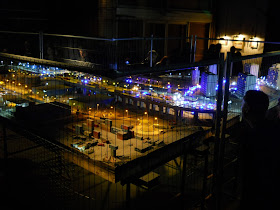The exhibition has been laid out like a small theme park with a decidedly dystopian air. It has been put together at a tiny derelict waterpark on the seafront at Weston-super-mare near Bristol.
The 'Tropicana' was well-known in these parts and many from Bristol, Weston and the surrounding area have fond memories of it. The artist Banksy is known to have strong links to the area and, I believe, was one of the main organisers of the exhibition. Perhaps he also remembers swimming there. It did seem the perfect place to stage the show.
Staff at the exhibition (identified by their pink "Dismal' tabards and Mickey-mouse-style ears) had been instructed to be deliberately rude to visitors and the ticket buying system was also deliberately made to be infuriating and random. Tickets were made more available to people living in the area via the local newspaper. One member of staff admitted in front of me that he'd stopped being horrible to people because everyone was being nice back and he couldn't be bothered to be nasty any more.
I have to say that I enjoyed Dismaland a lot more than I thought I would! I was slightly expecting an overhyped show full of irritating hipsters and, although there were quite a few art crowd types floating about, the exhibition was unusual and fun. A couple of heavy rain showers just seemed to add to the atmosphere and it was great to see it all lit up at night.
Fifty artists from 17 countries had been invited to show their work and these included some very well-known names such as Damien Hirst and Jenny Holzer. One of the pieces from Hirst's workshops was a white pony with a golden horn in a vitrine (a glass case full of preserving solution).
It didn't seem that particular fuss was made of the bigger names though, which was good to see. Many artist's work could only be identified by their names spray-painted with stencils on the floor or, like Mike Ross' 'Big Rig Jig' in the first photo, from the programme's descriptions. It wasn't possible to get photos of it all and, to be honest, you can probably find better images online anyway- as one staff member yelled at those taking photos near her. I'll just show a few that stood out for me and which I got reasonable shots of...
American Michael Beitz made this looping picnic table and the following toilet paper roll one. I like the sense of fun in his work.
Another American, Scott Hove, made a series of sculptures that look like vicious cakes:
Banksy put quite a few pieces into the exhibition, including the mermaid sculpture shown in a photo above and an installation with Death on the dodgems. He also showed the picture below.
I chuckled a bit to see that, despite all the other artists with work in Dismaland, the stencils on the pavements outside pointing the way to the show only had his name:
Jimmy Cauty showed a huge artwork called the Aftermath Displacement Principle. He and others made 3000 tiny figures of riot police for it over several years. Aged 17, Cauty produced a picture to illustrate the Lord of the Rings which became one of Athena's best-selling posters. He also co-founded the music projects the KLF, the Justified Ancients of MuMu and the Orb, all of which had a lot of success. He also, notoriously, burnt a million pounds as part of the K foundation with Bill Drummond. The piece at Dismaland was certainly epic too. It was a gigantic model diorama showing the immediate aftermath of a massive civil disorder, with the only figures visible being police.
I could have looked at it for ages as there was so much going on in the tiny world but the exhibition was closing and the staff were yelling even more than usual, so it was time to move on. In the programme, Cauty says that one of his favourite quotes about art is that:
'being an artist is like going on a journey and finding interesting artefacts, and bringing them back and showing them to people.'
Even though he's probably right when he also says that he thinks the sentiment in that saying is far more positive than the reality of being an artist, I still like it too.
There were a few artefacts by Maskull Laserre on display, including this one carved in wood:
Laserre's work has been mentioned in a previous post. He is based in Canada and often carves things into wooden objects. I wasn't sure about the finish left on some previous carvings, but it was possible to go right up to this one and the finish was excellently done even though some of the wood had obviously started to dote (softening up before rotting) and so must have been more difficult to work with. I also liked the sawdust and woodchips left inside the ribcage.
Laserre also works in other materials, including metal. A piece by him based around a chair and a trap was nearby.


































